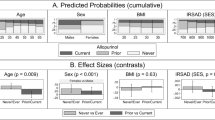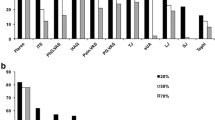Abstract
The aim of this study was to assess adherence rate and predictors of non-adherence with urate-lowering therapy (ULT) in Chinese gout patients. A cross-sectional study was administered to 125 gout patients using the Compliance Questionnaire on Rheumatology (CQR) for adherence to ULT. Patients were asked to complete the Treatment Satisfaction Questionnaire for Medication version II, Health Assessment Questionnaire, Confidence in Gout Treatment Questionnaire, Gout Knowledge Questionnaire, Patient Health Questionnaire-9, Generalized Anxiety Disorder-7, and 36-Item Short Form Health Survey. Data were analyzed by independent sample t test, rank sum test, Chi-square analysis as well as binary stepwise logistic regression modeling. The data showed that the rate of adherence (CQR ≥80%) to ULT was 9.6% in our investigated gout patients. Adherence was associated with functional capacity, gout-related knowledge, satisfaction with medication, confidence in gout treatment and mental components summary. Multivariable analysis of binary stepwise logistic regression identified gout-related knowledge and satisfaction of effectiveness with medication was the independent risk factors of medication non-adherence. Patients unaware of gout-related knowledge, or with low satisfaction of effectiveness with medication, were more likely not to adhere to ULT. Non-adherence to ULT among gout patients is exceedingly common, particularly in patients unaware of gout-related knowledge, or with low satisfaction of effectiveness with medication. These findings could help medical personnel develop useful interventions to improve gout patients’ medication adherence.
Similar content being viewed by others
Abbreviations
- MSU:
-
Monosodium urate monohydrate
- ULT:
-
Urate-lowering therapy
- sUA:
-
Serum urate
- BMI:
-
Body mass index
- WHR:
-
Waist hip ratio
- CQR:
-
Compliance Questionnaire on Rheumatology
- TSQM:
-
Treatment Satisfaction Questionnaire for Medication
- HAQ:
-
Health Assessment Questionnaire
- GKQ:
-
Gout Knowledge Questionnaire
- PHQ-9:
-
Patient Health Questionnaire-9
- GAD-7:
-
Generalized Anxiety Disorder-7
- SF-36:
-
36-Item Short Form Health Survey
- PCS:
-
Physical component summary
- MCS:
-
Mental component summary
- VAS:
-
Visual analog scale
References
Neogi T, Jansen TLTA, Dalbeth N, Fransen J, Schumacher HR, Berendsen D, Brown M, Choi H, Edwards NL, Janssens HJEM, Lioté F, Naden RP, Nuki G, Ogdie A, Perez-Ruiz F, Saag K, Singh JA, Sundy JS, Tausche A, Vaquez-Mellado J, Yarows SA, Taylor WJ (2015) 2015 Gout classification criteria: an American College of Rheumatology/European League Against Rheumatism collaborative initiative. Ann Rheum Dis 74(10):1789–1798
Liu R, Han C, Wu D, Xia X, Gu J, Guan H, Shan Z, Teng W (2015) Prevalence of hyperuricemia and gout in mainland China from 2000 to 2014: a systematic review and meta-analysis. Biomed Res Int 2015:762820
Kuo C, Grainge MJ, See L, Yu K, Luo S, Zhang W, Doherty M (2015) Epidemiology and management of gout in Taiwan: a nationwide population study. Arthritis Res Ther 17(1):13
Kuo CF, Grainge MJ, Mallen C, Zhang W, Doherty M (2015) Rising burden of gout in the UK but continuing suboptimal management: a nationwide population study. Ann Rheum Dis 74(4):661–667
Singh JA (2014) Facilitators and barriers to adherence to urate-lowering therapy in African-Americans with gout: a qualitative study. Arthritis Res Ther 16(2):R82
Shoji A, Yamanaka H, Kamatani N (2004) A retrospective study of the relationship between serum urate level and recurrent attacks of gouty arthritis: evidence for reduction of recurrent gouty arthritis with antihyperuricemic therapy. Arthritis Rheum 51(3):321–325
Jordan KM, Cameron JS, Snaith M, Zhang W, Doherty M, Seckl J, Hingorani A, Jaques R, Nuki G (2007) British Society for Rheumatology and British Health Professionals in Rheumatology guideline for the management of gout. Rheumatology (Oxford) 46(8):1372–1374
Zhang W, Doherty M, Bardin T, Pascual E, Barskova V, Conaghan P, Gerster J, Jacobs J, Leeb B, Liote F, McCarthy G, Netter P, Nuki G, Perez-Ruiz F, Pignone A, Pimentao J, Punzi L, Roddy E, Uhlig T, Zimmermann-Gorska I (2006) EULAR evidence based recommendations for gout. Part II: management. Report of a task force of the EULAR Standing Committee for International Clinical Studies Including Therapeutics (ESCISIT). Ann Rheum Dis 65(10):1312–1324
Kt R, Ca A (2003) Gout. JAMA 289:2857–2860
Richette P, Bardin T (2010) Gout. Lancet 375:318–328
De Vera MA, Marcotte G, Rai S, Galo JS, Bhole V (2014) Medication adherence in gout: a systematic review. Arthritis Care Res 66(10):1551–1559
McGowan B, Bennett K, Silke C, Whelan B (2016) Adherence and persistence to urate-lowering therapies in the Irish setting. Clin Rheumatol 35(3):715–721
Briesacher BA, Andrade SE, Fouayzi H, Chan KA (2008) Comparison of drug adherence rates among patients with seven different medical conditions. Pharmacotherapy 28(4):437–443
van Mierlo T, Fournier R, Ingham M (2015) Targeting medication non-adherence behavior in selected autoimmune diseases: a systematic approach to digital health program development. PLoS One 10(6):e0129364
Robinson PC, Schumacher HJ (2013) A qualitative and quantitative analysis of the characteristics of gout patient education resources. Clin Rheumatol 32(6):771–778
Singh JA, Hodges JS, Asch SM (2009) Opportunities for improving medication use and monitoring in gout. Ann Rheum Dis 68(8):1265–1270
de Klerk E, van der Heijde D, van der Tempel H, van der Linden S (1999) Development of a questionnaire to investigate patient compliance with antirheumatic drug therapy. J Rheumatol 26(12):2635–2641
Abdul-Sattar AB, Abou El Magd SA (2015) Determinants of medication non-adherence in Egyptian patients with systemic lupus erythematosus: sharkia Governorate. Rheumatol Int 35(6):1045–1051
Atkinson MJ, Kumar R, Cappelleri JC, Hass SL (2005) Hierarchical construct validity of the treatment satisfaction questionnaire for medication (TSQM version II) among outpatient pharmacy consumers. Value Health 8(Suppl 1):S9–S24
Bruce BFJ (2003) The Stanford Health Assessment Questionnaire: dimensions and practical applications. Health Qual Life Outcomes 1:20
Xia Y, Yin R, Fu T, Zhang L, Zhang Q, Guo G, Li L, Gu Z (2016) Treatment adherence to disease-modifying antirheumatic drugs in Chinese patients with rheumatoid arthritis. Patient Prefer Adherence 10:735–742
Dalbeth N, House ME, Horne A, Petrie KJ, McQueen FM, Taylor WJ (2012) Prescription and dosing of urate-lowering therapy, rather than patient behaviours, are the key modifiable factors associated with targeting serum urate in gout. BMC Musculoskelet Disord 13:174
Spaetgens B, Pustjens T, Scheepers LEJM, Janssens HJEM, van der Linden S, Boonen A (2016) Knowledge, illness perceptions and stated clinical practice behaviour in management of gout: a mixed methods study in general practice. Clin Rheumatol 35(8):2053–2061
Zhang LY, Schumacher HR, Su HH, Lie D, Dinnella J, Baker JF, Von Feldt JM (2011) Development and evaluation of a survey of gout patients concerning their knowledge about gout. J Clin Rheumatol 17(5):242–248
Li Q, Dai L, Li Z, Liu H, Zou C, Ou-Yang X, Lu M, Li T, Li Y, Mo Y, Schumacher HR (2013) Questionnaire survey evaluating disease-related knowledge for 149 primary gout patients and 184 doctors in South China. Clin Rheumatol 32(11):1633–1640
Leclair T, Carret A, Samson Y, Sultan S (2016) Stability and repeatability of the distress thermometer (DT) and the Edmonton symptom assessment system-revised (ESAS-r) with parents of childhood cancer survivors. PLoS One 11(7):e0159773
Spitzer RL, Kroenke K, Williams JB, Lowe B (2006) A brief measure for assessing generalized anxiety disorder: the GAD-7. Arch Intern Med 166(10):1092–1097
Spitzer RL, Kroenke K, Williams JB (1999) Validation and utility of a self-report version of PRIME-MD: the PHQ primary care study. Primary care evaluation of mental disorders. Patient Health Questionnaire. JAMA 282(18):1737–1744
Ware JE, Kosinski M, Keller SD (1994) SF-36 physical and mental health summary scales: a users manual. The Health Institute, New England Medical Centre, Boston
Ruoff G, Edwards NL (2016) Overview of serum uric acid treatment targets in gout: why less than 6 mg/dL? Postgrad Med 128(7):706–715
Latourte A, Bardin T, Richette P (2014) Prophylaxis for acute gout flares after initiation of urate-lowering therapy. Rheumatology 53(11):1920–1926
Tatlock S, Rudell K, Panter C, Arbuckle R, Harrold LR, Taylor WJ, Symonds T (2017) What outcomes are important for gout patients? In-depth qualitative research into the gout patient experience to determine optimal endpoints for evaluating therapeutic interventions. Patient 10(1):65–79
Wood R, Fermer S, Ramachandran S, Baumgartner S, Morlock R (2016) Patients with gout treated with conventional urate-lowering therapy: association with disease control, health-related quality of life, and work productivity. J Rheumatol 43(10):1897–1903
Chandratre P, Mallen CD, Roddy E, Liddle J, Richardson J (2016) “You want to get on with the rest of your life”: a qualitative study of health-related quality of life in gout. Clin Rheumatol 35(5):1197–1205
Perez-Ruiz F (2009) Treating to target: a strategy to cure gout. Rheumatology (Oxford) 48(Suppl 2):9–14
Spencer K, Carr A, Doherty M (2012) Patient and provider barriers to effective management of gout in general practice: a qualitative study. Ann Rheum Dis 71(9):1490–1495
Acknowledgements
We thank all researchers involved in this study. We acknowledge Zhanyun Da, Xinhang Zhu, Genkai Guo, and Yunfei Xia for their assistance in this study. This study was supported by grants from the Chinese National Natural Science Foundation (81671616 and 81471603), Jiangsu Provincial Commission of Health and Family Planning Foundation (H201317 and H201623), Science Foundation of Nantong City (MS22016028), and College graduate research and innovation of Jiangsu Province (KYZZ15-0353).
Author information
Authors and Affiliations
Corresponding authors
Rights and permissions
About this article
Cite this article
Yin, R., Cao, H., Fu, T. et al. The rate of adherence to urate-lowering therapy and associated factors in Chinese gout patients: a cross-sectional study. Rheumatol Int 37, 1187–1194 (2017). https://doi.org/10.1007/s00296-017-3746-x
Received:
Accepted:
Published:
Issue Date:
DOI: https://doi.org/10.1007/s00296-017-3746-x




